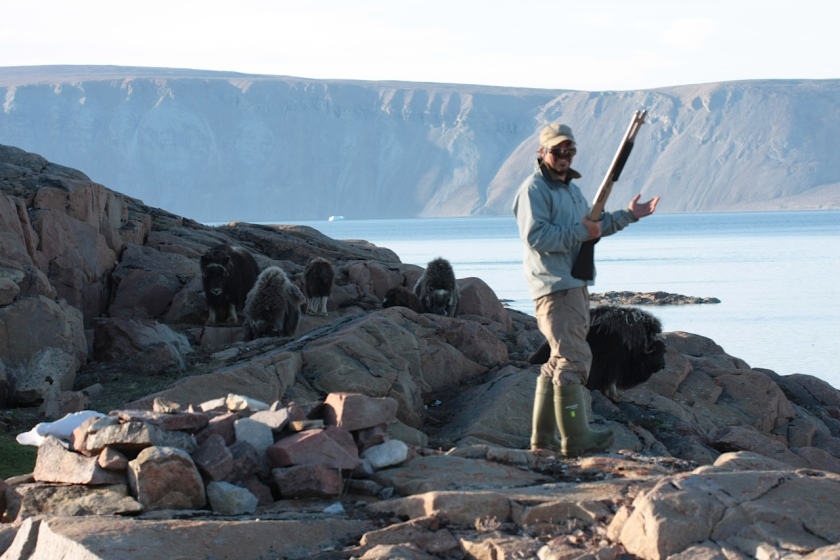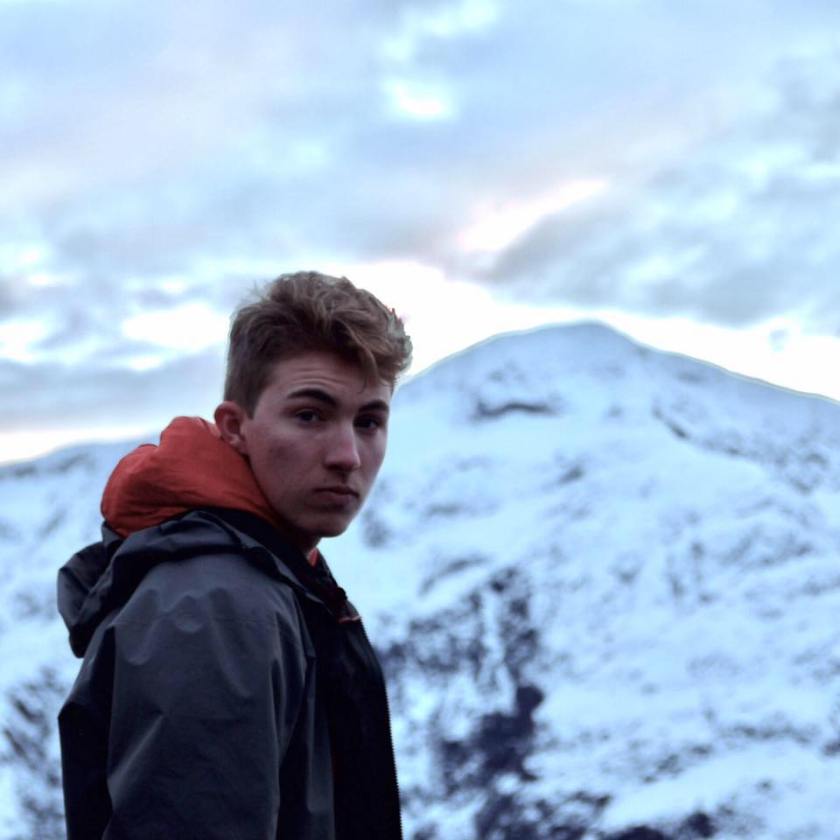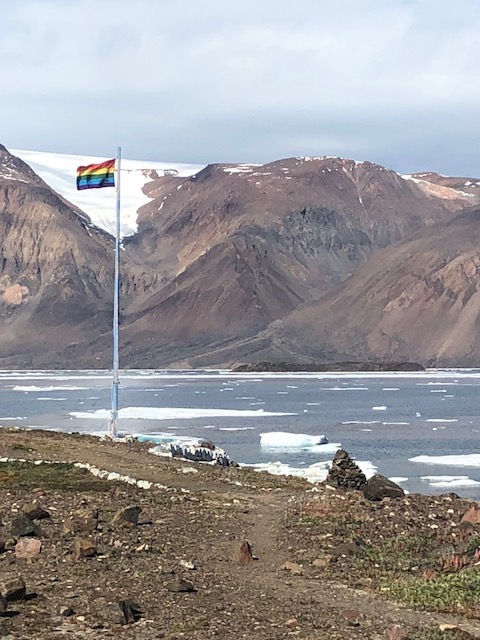I never thought I would have to stare down a muskox. But there I was, confronting a rag tag little herd of one bull, three cows and two calves. Whose campsite was this anyway? Cold winchester steel in hand and sunglasses on the end of my nose, I stood my ground. I’ve been charged by muskoxen before and I don’t take their presence lightly. I wanted them to go, but at the same time on this too warm of a high arctic day I didn’t want to see them run overheating across the tundra. In the end, I lost the battle of nerves and the shaggy beasts lay down to snooze barely 50 feet from our makeshift camp kitchen.

Thirteen years ago I first came to the high arctic, a place abundantly rich in the archaeological evidence of palaeo-Inuit cultures, the western remains of more recent RCMP encampments, and the more subtle traces of contemporary Inughuit hunters that have ventured over from Greenland. Every year’s return brought evidence of change: glacial retreat, disappearing sea ice, ponds drying up. Here at 79 degrees history is everywhere, time seems somehow foreshortened.
The first peoples to walk through this land arrived 4500 years ago, subsisting by hunting the scarce land mammals. In those days sea level was higher, the land still rebounding from the melt of an ice age. Standing in their campsites, you can still feel their presence, the immense odds they faced as they struggled to squeeze a life from a cold and brutal environment. The prayers sent out for the next day’s hunt hang echoing in the air. Miniature carvings that the archaeologists have found suggest a mystical life: animal spirits, a human face screaming in anguish.
What was the meaning of death then? The life sustaining death of prey animals, hunters drunk on the warm elixir of blood, a kill at their feet. The heart rending slow death of a loved one emaciated by hunger, unable to live through the winter night. The ominous shuddering death of a community’s key hunter, hope for the future bleeding out on the ground.
Life at the top of the world was a vacillating shade of grey. It came and went with changes in climate, improvements in technology, and simple luck. After the pre-Dorset and Dorset peoples had lived in Canada’s high Arctic for an inconsistent 3000 years, the Thule people started making their way west to east from Alaska to Greenland, populating the Canadian arctic archipelago as they went. Change was afoot. Nobody knows what happened to the Dorset as the Thule appeared. Were they killed or driven from the land, assimilated into a technologically superior culture, or did they simply fade into the landscape that had sustained them? The Thule introduced a maritime culture, the kayak and umiak, harpoons, dogs, the ability to hunt seal, walrus and narwhal.
It is easy to understand the advantage that marine hunting would bring. We went for a long wind blown walk on the Knud Peninsula. Hoping beyond hope for the sighting of a caribou or even the now elusive muskoxen, we came foot sore to the height of land as the guttural grunts of walrus teased us from below. Even with a marine advantage, the Thule faltered. Around 400 years ago the Thule disappeared from Ellesmere Island. Looking to the east now on a clear day the shores of Greenland are just visible. Somewhere in the soft arctic half light between here and there is drawn a line between ice floes, sovereign nations staring each other down in a battle of wits. Somewhere in that half light, on the other side of the line, are the closest living relatives of the Thule people that lived and died on these lands and waters, the Inughuit of Greenland.
Not far from our camp the archaeologists have found evidence of yet another culture, the Vikings. A piece of chain mail, wool, rivets and a carpenter’s plane were unearthed amongst the remains of a Thule winter camp. Historians tell us the Vikings didn’t make it this far north, and yet here is the evidence hard and tangible. What was that contact like? Was there hatred and fear, shock and respect, or did they even meet? Did the Thule people simply come across the corpses and remains of a viking ship blown off course, or were these artifacts the result of a trade with Greenlandic cousins?
The next day we paddle off toward a new campsite. As we weave our way between walrus and ring seal, eiders pass us by, each little flock in effortless synchronicity. These waters are a polynya, a place that never freezes, a concentration of year round swimming fat and protein. Landing to stretch our legs on a rocky island, we walk among remnants of a hunting culture that hasn’t ceased. Danish writing on cans of spam points assertively to the fact that this is a hunting ground of contemporary, as well as ancient, peoples. This place has never stopped being a source of life for people as inextricably tied to their land as the ptarmigan we find hiding amongst the rocks.
It was Otto Sverdrup, a Norwegian, that first mapped this land. In the spring of 1899 he passed through here on dog sled, continuing west to a height of land where he saw what he would later prove to be the west coast of Ellesmere Island. Sverdrup was driven, not by the holy grails of the Northwest Passage or the North Pole, but by insatiable human curiosity, the need to explore. It was Sverdrup’s expeditions that gave legitimacy to the Norwegian claim to the high arctic islands called Ellesmere, Axel Heiberg, Amund Ringnes and Ellef Ringnes. In 1930 a $67,000 payment to Sverdrup’s family from the Canadian government extinguished that claim. In the end, the relative lack of human misery on Sverdrup’s arctic explorations overshadowed the fact that he mapped more than any other arctic explorer.
That afternoon we stop in at an old RCMP post from the 1920s. Here the first Canadians stood in a land claimed simply because it lay to the north. It was the muskoxen that brought Canadians to this land. Stirred by Greenlandic stories of hunting trips to the west, the RCMP planted a Canadian flag and set up camp. Here they survived a few years with the help and tutelage of hired Greenlanders. Now all that remains is wind, graves, and the detritus of the past. The post was abandoned and then decades later moved across Buchanan Bay to Alexandra Fiord where the buildings still stand. Abandoned a second time, they stood empty until scientists and the occasional adventurer put them to summer time use.
Whose land is this anyway? As Canadians we scream “it’s ours, it’s ours.” At the old RCMP post in Alexandra Fiord stands a cairn freshly built by Canadian Rangers from Grise Fiord. Built by hands from a community forcibly moved from northern Quebec, abused in the name of Canadian sovereignty, then sent out on a government funded patrol to protect sovereignty. Protect from whom? From the only people that have ever lived unaided in this beautifully harsh land? From oil or mineral extraction companies that woo political favour?
We are our own greatest sovereign enemies. Our own resource intensive lifestyles work toward obliterating the delicate balance of life and death in the high arctic. In the meanwhile we scramble to build political walls to protect what we deem ours, ignoring and ignorant of what we claim.
Since first visiting the arctic I have never wholly left. In bed at night I can watch the terns diving and a solitary polar bear stand up, stretch his back and satiate his curiosity about our campsite. Waiting in a busy airport I can close my eyes and see the soft arctic light, taste freshly hunted blood on my lips. I am haunted by the arctic’s past and unable to distinguish it from the reality of today.
The muskoxen made their statement. They slept for a few hours and then, content that this place was still theirs they wandered off, disappearing into the bleak rocky landscape. We spent a couple of nights in that campsite. We thought ourselves victors in a territorial battle, but clad in our high tech fabrics we always stood painfully out from the landscape. Somehow, the land still belonged to the creatures that live there and the haunting memories of peoples past. And then, we were gone.
Author: Dave Weir Photo: Mike Jelinski









